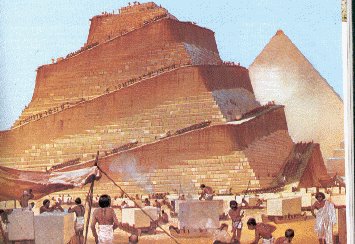Construction of the Great Pyramid of Giza in Egypt

Till the death of Rhampsinitus, the priests said, Egypt was excellently governed, and flourished greatly; but after him Cheops succeeded to the throne, and plunged into all manner of wickedness. He closed the temples, and forbade the Egyptians to offer sacrifice, compelling them instead to labour, one and all, in his service. Some were required to drag blocks of stone down to the Nile from the quarries in the Arabian range of hills; others received the blocks after they had been conveyed in boats across the river, and drew them to the range of hills called the Libyan. A hundred thousand men laboured constantly, and were relieved every three months by a fresh lot. It took ten years' oppression of the people to make the causeway for the conveyance of the stones, a work not much inferior, in my judgment, to the pyramid itself. This causeway is five furlongs in length, ten fathoms wide, and in height, at the highest part, eight fathoms. It is built of polished stone, and is covered with carvings of animals. To make it took ten years, as I said - or rather to make the causeway, the works on the mound where the pyramid stands, and the underground chambers, which Cheops intended as vaults for his own use: these last were built on a sort of island, surrounded by water introduced from the Nile by a canal. The pyramid itself was twenty years in building. It is a square, eight hundred feet each way, and the height the same, built entirely of polished stone, fitted together with the utmost care. The stones of which it is composed are none of them less than thirty feet in length.
Construction of the Great Pyramid of Giza in Egypt

0 Comments:
Post a Comment
<< Home